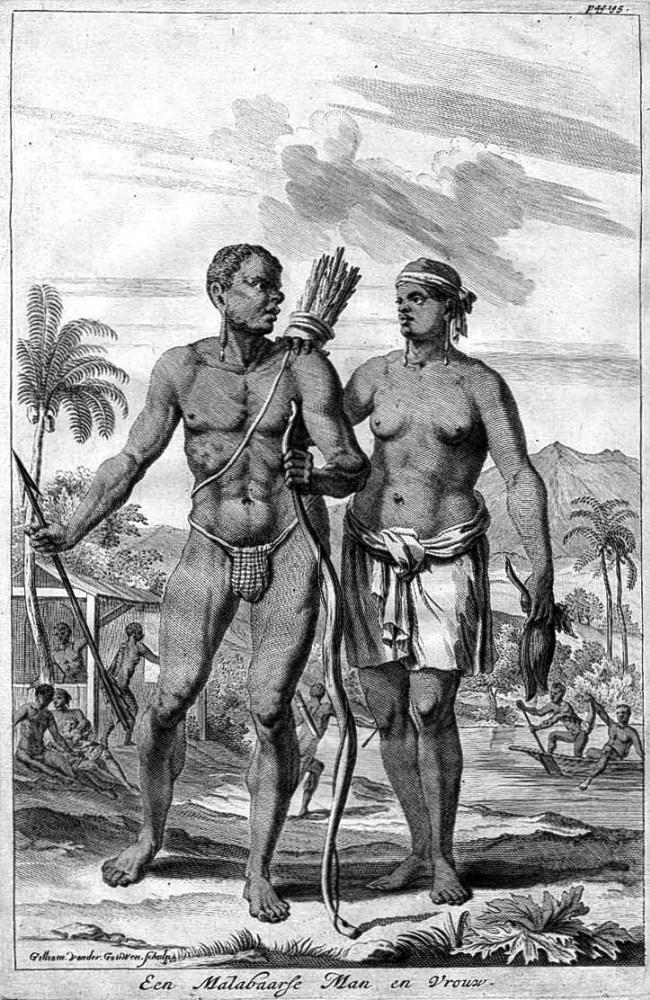
European Struggle for India: Southeast Coast--The Malabar Coast

Figure 1.--The Portuguese were the first Europeans to establish maritime trade with the East. Much of their trading posts were along the southwest, HGoa south to the Malabbar coast. The Dutch were the first Europeanhs to challenge the Portuguese monopoly. India was a huhe patchwork if different peiples and tates. Somje Indians were primitive people. Others were highly sophisticated. This is Dutch engraving depicting people along the Malabar coast (modern Kerala). Portugal and the Nethererlands were small countries. Neither had the capability of colonizing India. Nor were they capable of defending their Indian trading posts from larger European powers. This would be decided by he English nd French durig the Seven Years War (1756-63). The developing Travancore Kingdom would side with the British.
|
|
The Portuguese effort to establish maritime trade routes with the East finally became possible when Bartolomeu Dias rounded the Cape of Goo Hope (1488). Shortly after Vasco de Gama becan the European contact with the East when Vasco da Gama landed in Calicut (modern Kozhikode). For reasons of geopgraphy, the Portuguese trading posts was primarily in the southwest, Goa south to Malabar/Kerala. The Arabs resisted, but the decisive battle of Diu (1509) gave the Portuguese mastery of he Indian Ocean. The Dutch arrived next and challenged the Portuguese. The Dutch-Portuguese War (1602-61) was an extended conflict between the United Provinces and the Portuguese Empire over the new highly profitable trade routes and colonies. The conflict primarily involved the Dutch companies invading Portuguese colonies in the Americas, Africa, India and the Far East. The Dutch seized many of the Portuguese trading posts along the siutheast Malabar coast, but were also active along the eastern coast as well as Ceylon/Sri Lanka. Portugal and the Nethererlands were small countries. Neither had the capability of colonizing India. Nor were they capable of defending their Indian trading posts from larger European powers. This would be decided by he English nd French durig the Seven Years War (1756-63). The developing Travancore Kingdom would side with the British.
CIH

Navigate the Children in History Website:
[About Us]
[Introduction]
[Animals]
[Biographies]
[Chronology]
[Climatology]
[Clothing]
[Disease and Health]
[Economics]
[Ethnicity]
[Geography]
[History]
[Human Nature]
[Law]
[Nationalism]
[Presidents]
[Religion]
[Royalty]
[Science]
[Social Class]
[Bibliographies]
[Contributions]
[FAQs]
[Glossaries]
[Images]
[Links]
[Registration]
[Tools]
[Children in History Home]
Navigate the Boys' Historical Clothing national pages:
[Return to the Main Indian Travancore Kingdom period]
[Return to the Main Indian history British period]
[Return to the Main Indian royalty page ]
[Return to the Main Indian history page]
[Return to the Main Pakistani history page]
[Return to the Main countries page]
[Australia]
[Banladesh]
[Burma]
[China]
[India]
[Indonesia]
[Japan]
[Korea]
[Malaysia]
[Nepal]
[Pakistan]
[Sri Lanka]
[England]
Created: 10:33 AM 5/7/2018
Last updated: 10:33 AM 5/7/2018



